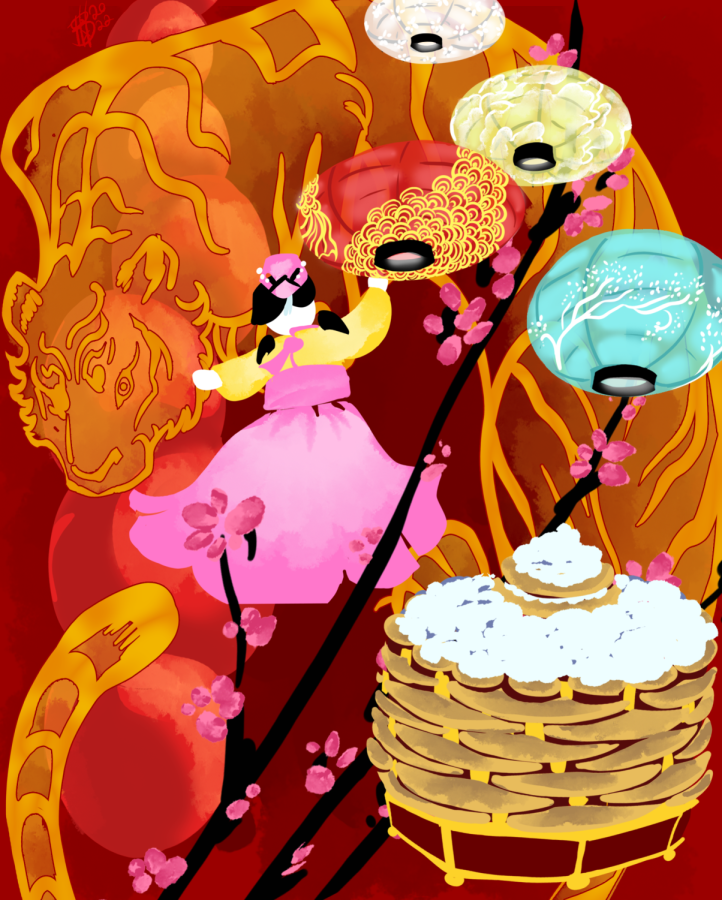Lunar New Year is celebrated with a ‘wholesome festival’
This illustration depicts celebrations of the Lunar New Year, which is celebrated all over the globe. This Year of the Tiger collection features decorations and treats from several various countries.
February 1, 2022
The Lunar New Year is a festival recognized by many East Asian countries. At Oregon State University, Asian students and organizations celebrate with family and unique traditions, including some COVID-19 adjustments.
The Lunar New Year marks the first new moon of the lunisolar calendar. It occurs on Feb. 1 in 2022, the Year of the Tiger, but varies in date annually within the more widely used Gregorian calendar.
Some countries that celebrate the holiday include China, Vietnam, South Korea, Japan and Malaysia.
In China, traditional festivities typically last for about 15 days and include a break from school and work for students and adults across the country.
Family members from various regions of China migrate to celebrate traditions together, including making offerings and prayers to ancestors and gods for prosperity and fortune, decorations with red lanterns and flowers, fireworks and food such as dumplings.
Leon Song, a Chinese American student and member of the Chinese Students and Scholars Association at OSU, said Lunar New Year celebrations create happiness and hope for new beginnings. His family cleans the house, shops for food and visits the Buddhist temple to pray for good luck and health in the New Year.
Meisen Hu, a Chinese international student at OSU-Cascades, said the loud fireworks set off in celebration in rural areas of China made it difficult to sleep at night.
“For two weeks, the streets will smell like a battlefield [with] burned black powder,” said Hu.
According to Donghyung Lee, president of the Korean Student Association, the Lunar New Year offers a chance for families to gather together and celebrate the Lunar New Year in Korea. Lee said a fun superstition connected to the holiday is that people need to eat duck-gook, or rice cake soup, in order to get one year older.
Despite the numerous countries and cultures that celebrate the Lunar New Year, many traditions overlap between regions.
Benson Ton, the community relations representative for the Asian and Pacific Cultural Center, said traditions common to China, Vietnam and Japan include the lion dance, using the color red to ward off bad spirits and elders and parents giving red envelopes—or lucky money—to children.
“[You give lucky money] when you can provide for yourself,” Ton said. “You’re giving it back to the next generation.”
Ton said some Lunar New Year traditions are personal, depending more heavily on each family or religion.
Ton, who is Buddhist and Asian American with Vietnamese and Laotian heritage, said his family goes to the temple to pray to their ancestors and leave fruit and flowers at their graves on the Lunar New Year.
A unique Vietnamese tradition during Lunar New Year includes wearing a traditional dress called the ao dai. It is worn primarily by women but also by men.
“I feel like a lot of our generation is struggling with trying to keep hold of our language and culture,” Ton said. “Especially when you’re speaking English every day, it’s hard to practice our language.”
With the exception of this year because of COVID-19 restrictions, Hu said he usually celebrates Lunar New Year with Asian friends and families since he can’t return to China during the school year.
“To be honest, I don’t really think it’s a downside that I won’t be able to celebrate it with my family,” Hu said. “It’s just a wholesome festival, [so] I don’t complain.”
According to Hu, he associates the festival more with his childhood, is open-minded and enjoys celebrating a variety of holidays with friends and other families.
“What we do in Korea during the Lunar New Year is meet up with family and relatives, but we cannot do [that] here since most of us are international students,” Lee said.
The CSSA plans to host China Night on Feb. 12 in the Memorial Union Ballroom. The event aims to recognize Lunar New Year through Chinese culture, including traditional dancing and singing. Song said the event may be live-streamed for students and families depending on COVID-19 infection rates on campus.
Ton said the APCC does not currently host Lunar New Year events because it is difficult to encompass all the various nationalities and their cultural traditions for the holiday. However, the APCC supports individual organizations’ events.
The Lunar New Year is to have originated in China under the Shang Dynasty, which ruled from about 1600 to 1046 B.C. when the Chinese would celebrate with sacrifices to gods and ancestors.
Later, under the Zhou Dynasty, the legend of Nian, a sea creature who ate livestock, crops and people on the New Year, became widespread. Lighting fireworks and displaying the color red, which are now traditional ways of celebrating the new year, frightened Nian and forced it back into the sea.
According to Ton, people make amends during the holiday.
“No one is ever in a bad mood [during Lunar New Year],” Ton said. “Even if you are in a bad mood and you spread negativity to others, it’s bad luck because you’re going into the New Year with all this bad aura.”
























































































































